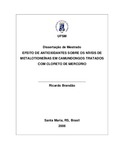| dc.creator | Brandão, Ricardo | |
| dc.date.accessioned | 2017-04-26 | |
| dc.date.available | 2017-04-26 | |
| dc.date.issued | 2006-02-23 | |
| dc.identifier.citation | BRANDÃO, Ricardo. Effect of antioxidants on metallothionein levels in mice treated with mercuric chloride. 2006. 90 f. Dissertação (Mestrado em Bioquímica) - Universidade Federal de Santa Maria, Santa Maria, 2006. | por |
| dc.identifier.uri | http://repositorio.ufsm.br/handle/1/11142 | |
| dc.description.abstract | In this study, acute effects of mercury on mouse blood, kidneys and liver were evaluated. Mice received a single dose of mercuric chloride (HgCl2 - 4.6 mg/kg, subcutaneously) for three consecutive days. We investigated the possible beneficial effects of antioxidant therapy (N-acetylcysteine (NAC) and diphenyl diselenide (PhSe)2) comparing to sodium salt of 2,3-dimercapto-1-propanesulfonic acid (DMPS), an effective chelating agent on mercury exposure in mice. We also verified if metallothionein (MT) induction would be involved in a possible mechanism of protection against mercury poisoning and if different therapies would modify MT levels and other toxicological parameters. The results demonstrated that animals treated with mercuric chloride presented a reduction in the body weight gain and therapies did not were effective in reverting this damage. HgCl2 exposure inhibited δ-aminolevulinic dehydratase (δ-ALA-D) activity in liver and only DMPS treatment prevented the inhibitory effect. Animals treated with mercury presented an increase in renal NPSH and therapies did not modify these levels. Urea concentration was increased after mercury exposure. NAC plus (PhSe)2 was partially effective in protecting against this effect of mercury . DMPS and (PhSe)2 were effective in restoring the increment in urea concentration caused by mercury. Thiobarbituric acid-reactive substances (TBARS), ascorbic acid levels, aspartate (AST) and alanine (ALT) aminotransferases were not modified after mercury exposure. Moreover, mercury poisoning caused an increase in hepatic and renal MT levels and antioxidant therapies did not modify this parameter. Our data pointed out the lack of the therapeutic effect of antioxidants tested. | eng |
| dc.description.sponsorship | Coordenação de Aperfeiçoamento de Pessoal de Nível Superior | |
| dc.format | application/pdf | por |
| dc.language | por | por |
| dc.publisher | Universidade Federal de Santa Maria | por |
| dc.rights | Acesso Aberto | por |
| dc.subject | Cloreto de mercúrio | por |
| dc.subject | Disseleneto de difenila | por |
| dc.subject | Metalotioneínas | por |
| dc.subject | Ácido 2,3-dimercapto-1-propanosulfônico | por |
| dc.subject | N-acetilcisteína | por |
| dc.subject | Mercuric chloride | eng |
| dc.subject | Diphenyl diselenide | eng |
| dc.subject | Metallothionein | eng |
| dc.subject | 2,3-dimercapto-1-propanesulfonic acid | eng |
| dc.subject | N-acetylcysteine | eng |
| dc.title | Efeito de antioxidantes sobre os níveis de metalotioneínas em camundongos tratados com cloreto de mercúrio | por |
| dc.title.alternative | Effect of antioxidants on metallothionein levels in mice treated with mercuric chloride | eng |
| dc.type | Dissertação | por |
| dc.description.resumo | Neste trabalho foram avaliados os efeitos da intoxicação aguda induzida por cloreto de mercúrio (HgCl2) em sangue, rim e fígado de camundongos. Os animais receberam uma única dose de HgCl2 (4,6 mg/Kg de peso), via sub-cutânea, por três dias consecutivos. Investigou-se o possível efeito protetor da terapia com antioxidantes (N-acetilcisteína-NAC e disseleneto de difenila-(PhSe)2) comparando ao ácido 2,3-dimercapto-1-propanosulfônico (DMPS), um agente quelante efetivo contra intoxicações por mercúrio. Além disto, foi verificado se a indução de metalotioneínas (MT) poderia estar envolvida em um possível mecanismo de proteção contra a intoxicação pelo mercúrio e se as diferentes terapias poderiam modificar os níveis de MT e outros parâmetros toxicológicos. Os resultados demonstraram que os animais tratados com cloreto de mercúrio apresentaram uma redução no ganho de peso corporal e as terapias não foram efetivas em reverter este dano. A exposição ao HgCl2 causou inibição na atividade da enzima δ-aminolevulinato desidratase (δ-ALA-D) em fígado de camundongos e somente a terapia com DMPS foi efetiva em reverter esta inibição. Os animais tratados com mercúrio apresentaram um aumento nos níveis de NPSH renal e as terapias não modificaram estes níveis. A concentração de uréia foi aumentada nos animais expostos ao cloreto de mercúrio. A terapia com NAC + (PhSe)2 foi parcialmente efetiva em proteger contra este efeito do mercúrio. Já as terapias com DMPS e (PhSe)2 foram efetivas em proteger contra o aumento nos níveis de uréia induzido pelo mercúrio. As substâncias reativas ao ácido tiobarbitúrico (TBARS), os níveis de ácido ascórbico e as transaminases (aspartato-AST e alanina-ALT) não foram alteradas após a exposição ao HgCl2. Além disso, os resultados demonstraram que a exposição ao mercúrio causou um aumento nos níveis de metalotioneínas hepático e renal e as terapias com antioxidantes não modificaram este parâmetro. Nossos dados apontam para a falta de efeito terapêutico dos antioxidantes testados. | por |
| dc.contributor.advisor1 | Nogueira, Cristina Wayne | |
| dc.contributor.advisor1Lattes | http://lattes.cnpq.br/2877042401245169 | por |
| dc.contributor.referee1 | Moretto, Maria Beatriz | |
| dc.contributor.referee1Lattes | http://lattes.cnpq.br/7317262818918502 | por |
| dc.contributor.referee2 | Soares, Félix Alexandre Antunes | |
| dc.contributor.referee2Lattes | http://lattes.cnpq.br/8752453650114092 | por |
| dc.creator.Lattes | http://lattes.cnpq.br/9154529811247631 | por |
| dc.publisher.country | BR | por |
| dc.publisher.department | Bioquímica | por |
| dc.publisher.initials | UFSM | por |
| dc.publisher.program | Programa de Pós-Graduação em Ciências Biológicas: Bioquímica Toxicológica | por |
| dc.subject.cnpq | CNPQ::CIENCIAS BIOLOGICAS::BIOQUIMICA | por |


